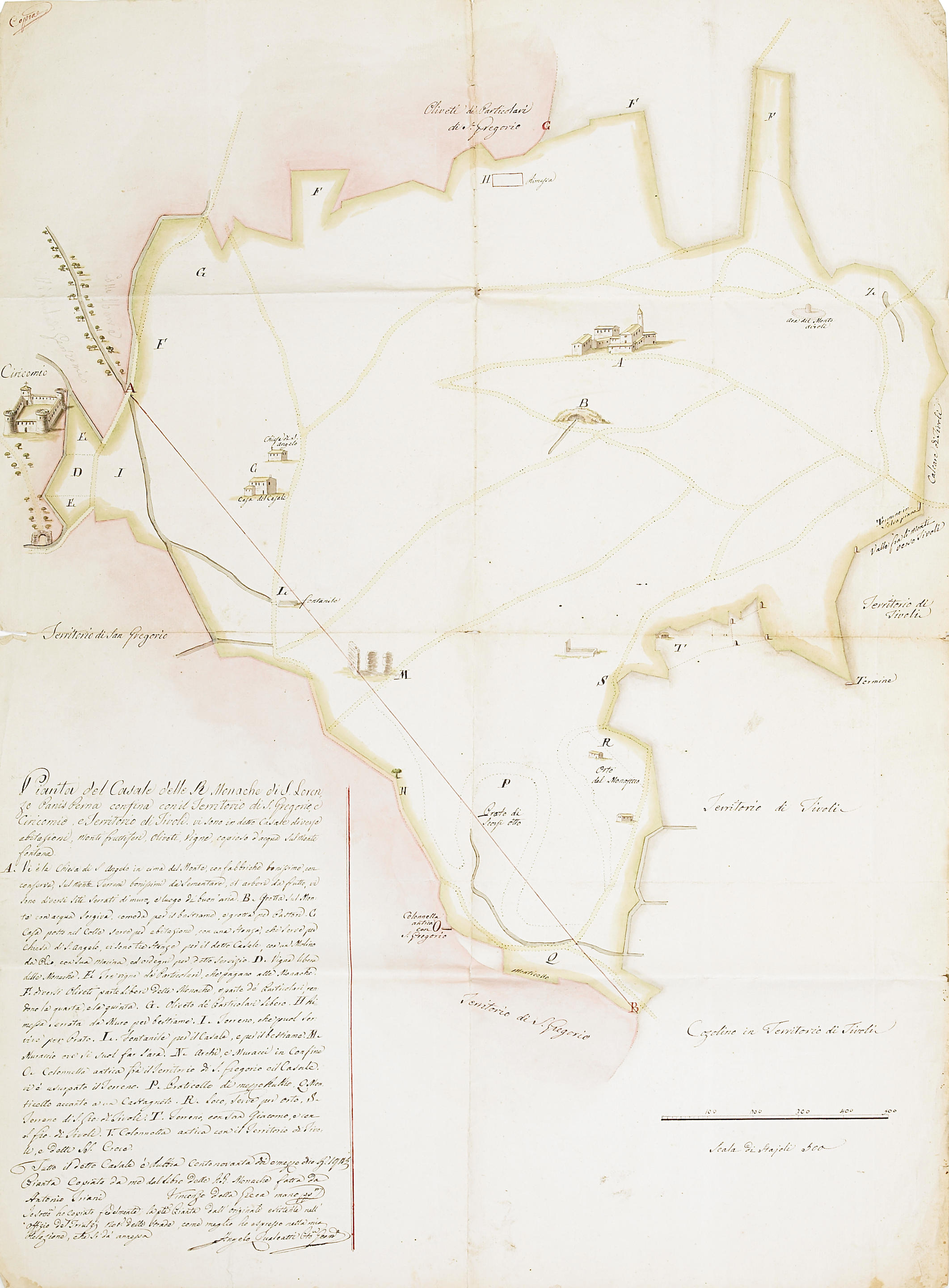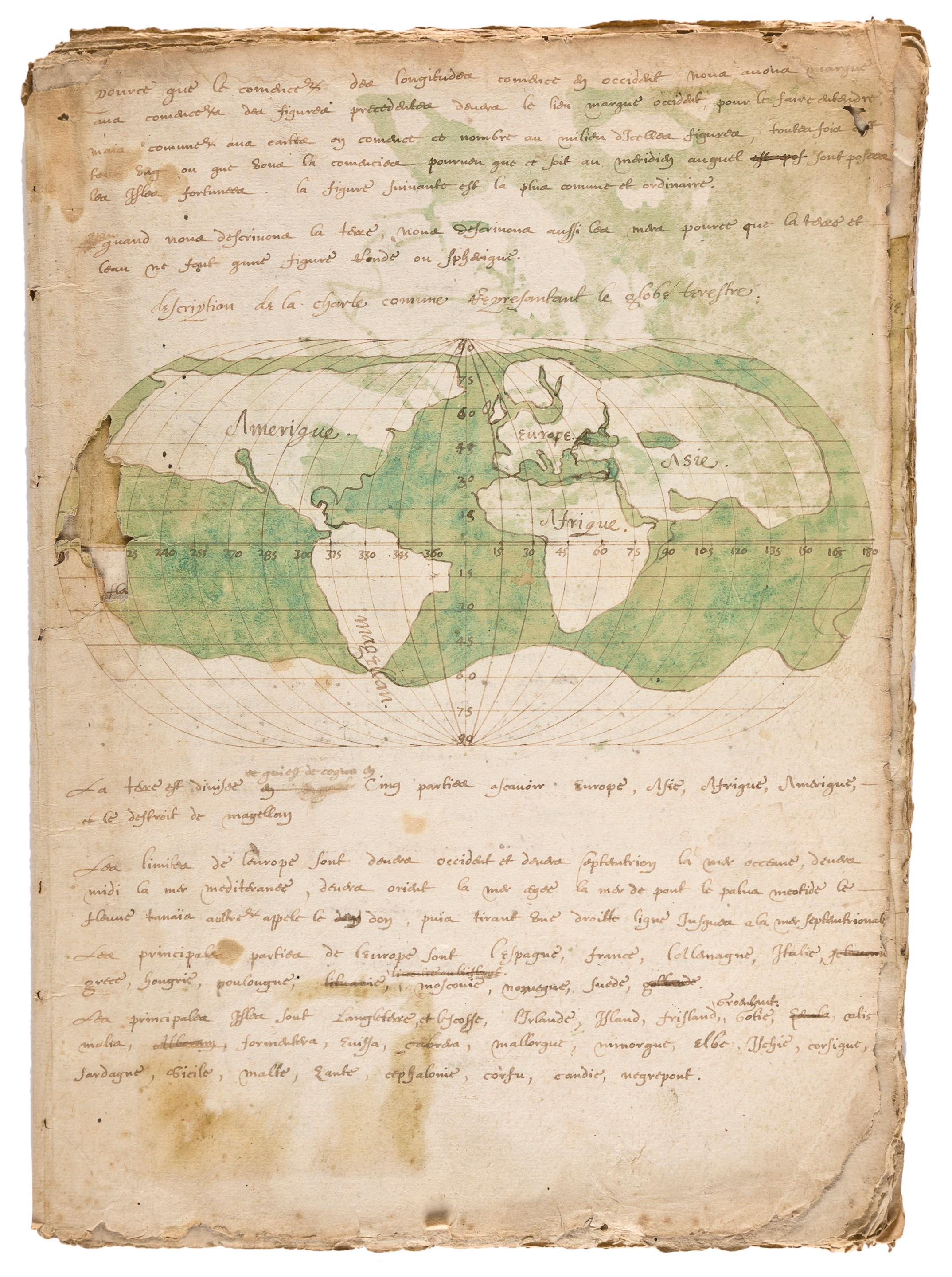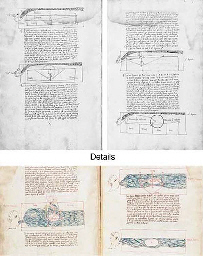ITALY - manuscript map on vellum. [Ferrara, 1441-1450]. 748 x 1150mm approximately. 2 membranes joined, drawn in brown ink and written in brown and pink ink in a variety of humanistic scripts, the names of Italy, Corsica, Sicily and Sardinia in gold capitals, the sea, lakes and rivers green bodycolour, valleys shaded grey-brown, towns represented by crenellated buildings of varying size and complexity coloured pink, the largest towns with blue backgrounds. (Large loss from left-hand edge, other small losses and tears, all restored, two old tears sewn, slight spotting of right-hand edge). AN IMPORTANT EARLY MAP OF ITALY. The map, oriented with the north on the left, extends from Aquileia in the upper left corner -- represented by the largest building on the entire map -- to the tip of Italy in the upper right, below are the islands of Corsica, Sardinia and Sicily with many of the smaller islands in the Tyrrhenian sea drawn but unnamed. Drawn above Corsica and Sardinia on the present map is a scroll carrying the legend 'H[oc] est Italiae descriptio singulariu[m] urbium: castellor[um]: atque locor[um]; alior[um] ite[m] mo[n]tium [?ill]uminu[m]. Qua[m] in letterar[um] cela divi p[ri]ncipi[s] leoneli estensis invenimu[s] ea[m]q[ue] dilige[n]tisi[m]e exe[m]pla/vimus' (This is a drawing of the individual cities, castles and regions of Italy and likewise of the various ?famous mountains; which we have found in the room of letters of the divine prince Leonello d'Este and have carefully copied out). Leonello d'Este, 13th Marchese of Ferrara ( reg .1441-1450) was a lavish patron of art and scholarship. His interest in these subjects had been fostered by the humanist Guarino da Verona who had been brought to Ferrara in 1429 by Leonello's father Niccolò III to teach at the University and to tutor his son. The 'cela litterarum' where the exemplum of the present map was kept seems most likely to refer to the renowned studiolo at Belfiore that was described by Angelo Candido Decembrio in De politia litteraria . Belfiore was the country palace where Leonello was living at the time of his death. The development of the idea of a study as a necessity for the contemplative life of a prince, equivalent to the cell of a monk, has been traced back to Petrarch: Wolfgang Liebenstein, 'Lo studiolo come luogo del principe', Le muse e il principe: Arte di corte nel Rinascimento padano , pp.135-139. From as early as the estude of Charles V of France (d.1380) maps were seen as appropriate items for inclusion among the selected books, papers, wonders and scientific objects that would provide inspiration to a ruler. In a letter of 1447 Guarino had suggested a decorative programme based on the Muses for the studiolo at Belfiore, and paintings and intarsie were being made in 1448. As the 'divi principis Leoneli Estensis' is referred to in the present, the map must have been made during Leonello's reign. This dating is entirely consistent with the script of the legend where miniscule letterforms are mixed with capitals. As well as being a direct reflection of the interests of one of the most cultured courts of the Renaissance, the present map is one of the earliest maps of Italy made after the translation of Ptolemy to have survived. Jacopo d'Agnolo della Scarperia completed his translation of Ptolemy's Geographia in 1406 and it went into circulation with the dedication to Alexander V in 1409. Around 1415 Francesco di Lapacino and Domenico di Lionardo Buoninsegni produced maps to accompany the text; these were seen and praised by the Florentine bookseller Vespasiano da Bisticci. The surviving Ptolemeic maps of Italy produced after this date were discussed by Luciano Lago in Imago mundi et Italiae (Trieste, 1992). Most of them are in codices and are close to the maps in earlier Greek manuscripts; for example, the map in Vat.Lat.5698 of the Biblioteca Apostolica Vaticana that is attributed to the first half of the 15th century and appears to be directly deri
ITALY - manuscript map on vellum. [Ferrara, 1441-1450]. 748 x 1150mm approximately. 2 membranes joined, drawn in brown ink and written in brown and pink ink in a variety of humanistic scripts, the names of Italy, Corsica, Sicily and Sardinia in gold capitals, the sea, lakes and rivers green bodycolour, valleys shaded grey-brown, towns represented by crenellated buildings of varying size and complexity coloured pink, the largest towns with blue backgrounds. (Large loss from left-hand edge, other small losses and tears, all restored, two old tears sewn, slight spotting of right-hand edge). AN IMPORTANT EARLY MAP OF ITALY. The map, oriented with the north on the left, extends from Aquileia in the upper left corner -- represented by the largest building on the entire map -- to the tip of Italy in the upper right, below are the islands of Corsica, Sardinia and Sicily with many of the smaller islands in the Tyrrhenian sea drawn but unnamed. Drawn above Corsica and Sardinia on the present map is a scroll carrying the legend 'H[oc] est Italiae descriptio singulariu[m] urbium: castellor[um]: atque locor[um]; alior[um] ite[m] mo[n]tium [?ill]uminu[m]. Qua[m] in letterar[um] cela divi p[ri]ncipi[s] leoneli estensis invenimu[s] ea[m]q[ue] dilige[n]tisi[m]e exe[m]pla/vimus' (This is a drawing of the individual cities, castles and regions of Italy and likewise of the various ?famous mountains; which we have found in the room of letters of the divine prince Leonello d'Este and have carefully copied out). Leonello d'Este, 13th Marchese of Ferrara ( reg .1441-1450) was a lavish patron of art and scholarship. His interest in these subjects had been fostered by the humanist Guarino da Verona who had been brought to Ferrara in 1429 by Leonello's father Niccolò III to teach at the University and to tutor his son. The 'cela litterarum' where the exemplum of the present map was kept seems most likely to refer to the renowned studiolo at Belfiore that was described by Angelo Candido Decembrio in De politia litteraria . Belfiore was the country palace where Leonello was living at the time of his death. The development of the idea of a study as a necessity for the contemplative life of a prince, equivalent to the cell of a monk, has been traced back to Petrarch: Wolfgang Liebenstein, 'Lo studiolo come luogo del principe', Le muse e il principe: Arte di corte nel Rinascimento padano , pp.135-139. From as early as the estude of Charles V of France (d.1380) maps were seen as appropriate items for inclusion among the selected books, papers, wonders and scientific objects that would provide inspiration to a ruler. In a letter of 1447 Guarino had suggested a decorative programme based on the Muses for the studiolo at Belfiore, and paintings and intarsie were being made in 1448. As the 'divi principis Leoneli Estensis' is referred to in the present, the map must have been made during Leonello's reign. This dating is entirely consistent with the script of the legend where miniscule letterforms are mixed with capitals. As well as being a direct reflection of the interests of one of the most cultured courts of the Renaissance, the present map is one of the earliest maps of Italy made after the translation of Ptolemy to have survived. Jacopo d'Agnolo della Scarperia completed his translation of Ptolemy's Geographia in 1406 and it went into circulation with the dedication to Alexander V in 1409. Around 1415 Francesco di Lapacino and Domenico di Lionardo Buoninsegni produced maps to accompany the text; these were seen and praised by the Florentine bookseller Vespasiano da Bisticci. The surviving Ptolemeic maps of Italy produced after this date were discussed by Luciano Lago in Imago mundi et Italiae (Trieste, 1992). Most of them are in codices and are close to the maps in earlier Greek manuscripts; for example, the map in Vat.Lat.5698 of the Biblioteca Apostolica Vaticana that is attributed to the first half of the 15th century and appears to be directly deri














Try LotSearch and its premium features for 7 days - without any costs!
Be notified automatically about new items in upcoming auctions.
Create an alert